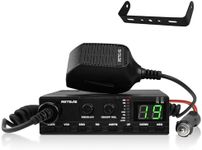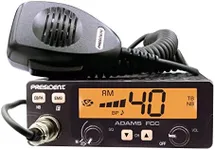Best Handheld Cb Radios
From leading brands and best sellers available on the web.
President Electronics
Randy II FCC - First FCC Approved AM/FM Handheld CB Radio

Midland
Midland 75-822 40 Channel CB-Way Radio
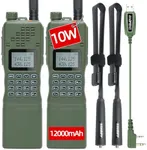
BAOFENG
Baofeng Radio AR-152 Ham Radio Handheld 10W Long Range Rechargeable Military Grade Upgrade UV-5R Two Way Radio with Tactical Antenna and Programming Cable walkie talkies Full Set(2 Pack)

President Electronics
President Walker III FCC AM/FM CB Radio, USB Charging Socket, Roger Beep, Mic Gain, Scan/Scan Skip, 2 Programmable Priority Channels, Talkback Function, Weather Channel, 40 Channels
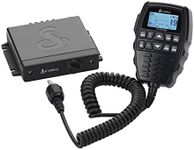
Cobra
24%OFF
Cobra 75 All Road Wireless CB Radio - Dual-Mode AM/FM, Full 40 Channels, Bluetooth Connectivity, Digital Noise Cancellation, Waterproof, Instant Channel 9, 4-Watt Output, Easy to Operate, Black

President
President Electronics RANDY Handheld Or Mobile Cb Radio
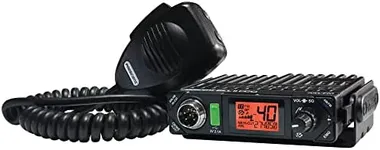
President
11%OFF
President Electronics Bill II FCC Ultra-Compact AM/FM CB Radio

Uniden
19%OFF
Uniden CMX760 Bearcat Off Road Series Compact Mobile CB Radio, 40-Channel Operation, Ultra-Compact for Easy Mounting, Large 7-Color Backlit LCD Display on Mic with Built-in Speaker Mic, Black

Cobra
17%OFF
Cobra 29 NW AM/FM Classic Professional CB Radio - Easy to Operate Emergency Radio, Travel Essentials, Instant Channel 9/19, Full 40 Channels, SWR Calibration and NightWatch Illumination Display, Black
Our technology thoroughly searches through the online shopping world, reviewing hundreds of sites. We then process and analyze this information, updating in real-time to bring you the latest top-rated products. This way, you always get the best and most current options available.

Most Popular Categories Right Now
 Yehudah Posnick
Yehudah PosnickYour Guide to Buying a Handheld CB Radio
Citizen’s Band (CB) radios, although invented in the 1950’s, became especially popular in the 1970s, when the United States set the speed limit at 55 mph. By means of CB radio, drivers could warn other drivers of police speed traps, where gas stations are located, and alert them in case of emergencies. Even though a lot of this has been superseded with smartphone apps and GPS devices, CBs still have a level of popularity among truckers, to communicate directions and any problems with traffic--as well as just for socializing. A portable CB works well in small spaces or to be moved around as it is more compact and light than other models, and is perfect for people looking for a short-range, two-way communication system.
We've put together this handheld CB radio buyer's guide to help you select the best handheld CB radio that answers to your needs. It'll help you:
-
Choose the right type of handheld CB radio,
-
See useful tips about that type of handheld CB radio,
-
Read reviews of different brands of handheld CB radio, and what customers are saying,
-
Select the right brand of handheld CB radio, and
-
Compare prices and find the best deals.
Types
We can distinguish between the types of handheld CB radio by the antenna that they employ:
-
Telescoping center-loaded whip: These will be ¼ of the wavelength of the frequency of the radio waves being received.
-
Continuously-loaded “rubber ducky” antenna: These consist of a springy wire sealed in a rubber or plastic jacket to protect the antenna. They are not as long as the telescoping antenna.
What Reviewers Have to Say
Based on all the consumers' reviews we've scanned, these are the top things they mentioned about their new stuff:
-
Incoming and Outgoing Sound Quality: One of the most important qualities that reviewers looked for in the CB radios was good quality sound, for both incoming and outgoing signals. Many reviewers who rated their models highly mentioned the clear sound they heard and noted with pride that their recipients had complimented the clarity of their signal.
-
Range: The Cobra HH38WXST Handheld CB Radio is an excellent radio claims to have a 4-mile range, but it seems to be closer to 2 miles in the woods, and 5 miles in an open city. There is also an extension antenna, which can allow communication with people up to 15 miles away.
-
Alerts: Reviewers were constantly impressed by how useful weather and emergency alerts were in helping them to avoid unpleasant conditions on their drive or other adventures. They were especially pleased to find that some models would turn on just to transmit an alert, even if the radio was not in use.
-
Controls: Users commented on the ease of button and knob use. It is important that when changing channels, volume, etc., that users can keep their eyes safely on the road. Models with complicated, awkward, or unclear controls were not rated as highly as others.
Important Features
-
Channels: There are 40 channels allotted for CBs in the United States, ranging from 26.965 MHz to 27.405 MHz. There are also weather and emergency alert channels. Many CB radio models come with National Oceanic and Atmospheric Administration (NOAA) weather and emergency alerts. This can be especially useful for those traveling long distances for long periods of time.
-
Radio Check Features: Some CB radio models will run diagnostics to check radio frequency (RF) power, vehicle voltage and antenna standing wave ratio (SWR) status. These features can be important to help those on long journeys avoid and assess technical difficulties.
-
Battery Power: Handheld CBs will require a large number of batteries. If they run on 12 Volts, they’ll require 9 AA batteries. You can get rechargeable batteries, where some hook up to your automobile’s 12 volt cigarette lighter to recharge them.
Top-Rated Brands
Midland--was founded in 1959, and they have their main office in Kansas City, Missouri. They make wireless communication devices, including: Wearable Action Cameras, Land Mobile radios, GMRS Two-Way Radios, Citizen Band (CB) Radios, Marine Radios, Bluetooth intercom systems, and All Hazards/Weather Alert Radios.
Cobra--was founded by Carl Korn in 1948 as B & K Electronics, making television servicing equipment. Under the name Dynascan, the company made the first citizen's band radio, which they named The Sidewinder. The next model was called The Cobra--which eventually became synonymous with CB radios. They also make radar detection equipment, marine electronics, mobile navigation, and two-way radio. Their main headquarters is in Chicago, Illinois.
Yaesu--was founded by the radio amateurist Sako Hasegawa in 1959, in the Tokyo neighborhood of Yaesu. He originally wanted to make commercial and amateur radio equipment, but he later went into the line of airband and marine radio as well. Some of their products are sold under the name Vertex Standard, Inc.
